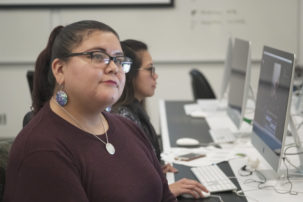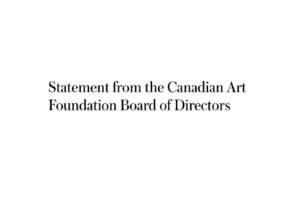A new open letter signed by more than 350 artists, curators and critics to date is protesting Emily Carr University of Art and Design’s “dismissal” of Cate Rimmer as director/curator of Vancouver’s Libby Leshgold Gallery.
Rimmer was reportedly out of the job on October 29 after working at the university’s gallery for some 23 years.
Prior to the open letter being issued, no public announcement or acknowledgment of the job change had been made by the university. In official comment since, the university insists Rimmer’s departure falls under “individual employment matters.”
The signatories of the open letter demand more information.
“The termination of an esteemed professional without cause or rationale, particularly in the midst of a pandemic, breaches and undermines the trust placed in your institution,” the open letter states. “Furthermore, the ruthlessness with which Rimmer has been dismissed sends a message that the administration of ECU does not value its gallery, nor the consequences of its action upon the communities it serves, let alone the negative impact on ECU’s reputation that the internationally-respected gallery in no small way has helped to build.”
Director Scott Watson and associate director Lorna Brown of UBC’s Morris and Helen Belkin Art Gallery, as well as director Reid Shier and curator Helga Pakasaar of the Polygon Gallery, worked with Simon Fraser University School for the Contemporary Arts director Elspeth Pratt to draft the open letter. Together, they made the letter public on November 17.
Since then, internationally renowned Canadian artists Brian Jungen, Stan Douglas, Ken Lum, Jeremy Shaw, Rodney Graham, Ron Terada, AA Bronson, Shannon Bool, Andrew Dadson, Mark Lewis and Corin Sworn, among others, have signed the letter. International artists Fiona Banner, Kota Ezawa and Gerard Byrne have pledged support of the open letter as well.
Several of these artists had works curated by Rimmer over the years, or learned directly from her as a student or peer.
Jeremy Shaw, for one, says Cate Rimmer is “someone who has shaped that gallery, school and city in immeasurable ways.”
“Cate’s commitment to the [ECU gallery] was evident in her consistently rigorous and engaged programming that explored the inside and outside of Vancouver and the art world at large,” Shaw, an ECUAD alumnus, states via email from Berlin. “She provided me and many of my peers with our first experiences exhibiting institutionally—oftentimes placing us within the context of far more established local and international artists.”
“I can’t overstate how much I learned from visiting Cate’s exhibitions…during my time at Emily Carr,” Shaw concludes. “It was a vital part of attending the school.”
Also signing the letter are a number of respected curators: Candice Hopkins, senior curator of the Toronto Biennial; Tarah Hogue, curator (Indigenous art) at Remai Modern; Nayia Yiakoumaki, archive curator at the Whitechapel Gallery; and Jordan Wilson, recent recipient of Independent Curators International’s inaugural Indigenous Curatorial Research Fellowship.
“The firing of Cate Rimmer after 23 years is unprecedented,” Hopkins states via email. “I knew of Cate’s work before I met her, when as a student just out of art school, someone handed me the catalogue of her show with Brian Jungen. That exhibition set the direction for the course of my career.
“Cate has continued to quietly make these ground-shifting exhibitions over the course of her career—such as Germaine Koh’s Fallow,” Hopkins notes. “Normally, staff such as Cate would be celebrated by an institution, particularly with such a long and celebrated tenure. The fact that they were willing to terminate her abruptly, in a moment of global instability, seems shortsighted and makes me concerned not only for the future of the [ECU] Gallery, but also how students will fare with one of the few public resources on campus now shuttered.”
Rob Maguire, director of communications at ECUAD and speaking on behalf of the institution, said in an interview with Canadian Art that the gallery will remain a vital part of the university.
Maguire states that Rimmer’s job change “is strictly a personnel issue, not an issue about the gallery’s role within the university.”
He also confirmed that other staff and staffing structures at Libby Leshgold Gallery will remain intact.
“ECU’s galleries play an incredibly important role, serving our university community while engaging with the cultural sector and the public,” Maguire added via email. “Although we can’t comment on individual employment matters, we are absolutely committed to a strong and vibrant future for our galleries and exhibitions.”
Maguire also indicates that the university is looking ahead to hiring a new director/curator for its gallery. “As we begin the search for new leadership in this area, we’ll be consulting with our community to learn how the university can best support the creation of inclusive and innovative gallery programs that reflect a wide diversity of voices,” Maguire says.
That’s not enough assurance for Reid Shier, who besides being director of the Polygon Gallery and a drafter of the open letter is also curator of the Stan Douglas exhibition being featured in the Canada Pavilion at the next Venice Biennale.
“It’s one thing to say you are are going to continue the gallery,” Shier tells Canadian Art in an interview. “It’s another to say you value the gallery’s independent critical and curatorial autonomy…. I would hope that they would commit to that.”
A number of artists continue to ponder what’s happened, and what might happen next.
And the list of signatories of the letter continues to grow; it now includes artists Tania Willard, Myfanwy Macleod and Maureen Gruben.
“I have known Cate Rimmer for 20 years,” says Macleod via email. “She’s an amazing curator/director and the faculty, staff, students at Emily Carr University, as well as the local, national and international community, all benefited from her thoughtful and insightful practice.”
“You can see from the list of signatories the kind of impact she had,” Macleod adds. “I signed because I’m appalled by the behaviour of the administration who dismissed her without cause in the middle of a pandemic.”
In national scope, some say the shift of Cate Rimmer at ECU also sends a signal about wider threats to university galleries in Canada.
“In the past few years, there is a disturbing trend in Canada to undermine the important role of art school galleries,” concludes curator Candice Hopkins via email. “[This] follow[s] the firing of Wayne Baerwaldt at the Alberta University of the Arts, and now Cate, at a time when institutions should be shoring up their strengths instead of eroding them.”

 A view of Emily Carr University of Art and Design in Vancouver. Photo: roaming the planet via Flickr. CC BY-NC-ND 2.0.
A view of Emily Carr University of Art and Design in Vancouver. Photo: roaming the planet via Flickr. CC BY-NC-ND 2.0.







